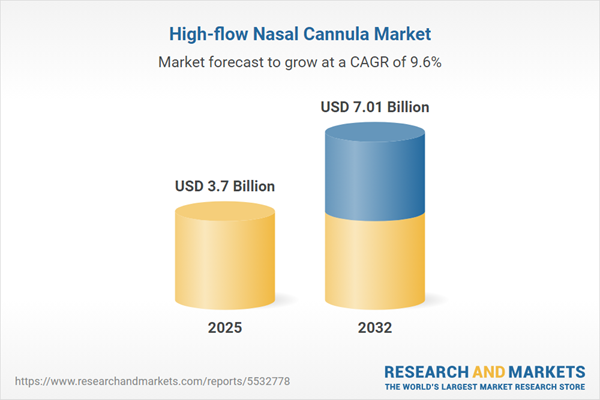Speak directly to the analyst to clarify any post sales queries you may have.
The high-flow nasal cannula (HFNC) market is evolving rapidly as global healthcare providers invest in more advanced, connected respiratory solutions for both acute and home-based care. Senior decision-makers are seeking technologies that streamline workflow, support patient-centered care, and align with long-term strategic objectives in today's changing procurement landscape.
Market Snapshot: High-Flow Nasal Cannula Market Size and Growth
The global high-flow nasal cannula market is undergoing robust growth, integrating new technologies across both acute clinical environments and home care applications. Market dynamics are currently shaped by increasing demands for minimally invasive respiratory support, driving adoption among hospitals and care organizations. Key trends include widespread implementation of system interoperability and real-time analytics, which enhance clinical outcomes and align device selection with broader operational priorities. Emerging advances in digital health and data-driven care models are solidifying HFNC's role as a crucial component in modern respiratory support protocols. As hospitals and outpatient centers prioritize seamless clinical workflows, these innovations set a new standard for device procurement and use globally.
Scope & Segmentation of the High-Flow Nasal Cannula Market
The high-flow nasal cannula market features rapidly advancing technologies, responding directly to the evolving needs of healthcare organizations. This detailed segmentation allows procurement leaders and senior decision-makers to align product selection with institutional goals, operational requirements, and patient populations.
- Product Type: Options include single-use and reusable systems, enabling both hospital-based infection control and flexible deployment in home care scenarios.
- Flow Rate: Devices are designed to address a wide range of care requirements, from acute interventions to ongoing respiratory management.
- Component: Solutions integrate air oxygen blenders, heated humidifiers, nasal interfaces, and application-specific tubing, with features enhancing both patient comfort and clinical results.
- Age Group: Portfolio spans adult, pediatric, and neonatal segments, supporting tailored care across diverse demographics.
- Oxygen Source: Configurations operate with central supply pipelines, onsite compressors, or portable oxygen cylinders, supporting compatibility in varied care settings.
- End User: Hospitals, ambulatory care centers, sleep clinics, and home care organizations represent the core drivers of market adoption and clinical innovation.
- Application: Technologies address acute respiratory distress, perioperative care needs, and long-term chronic management—facilitating rapid adaptation to institutional and outpatient use.
- Distribution Channel: Procurement is enabled through direct sales, established distributors, and e-commerce platforms, allowing for agile supply management and cost control.
- Regional Coverage: The market encompasses the Americas, Europe, Middle East & Africa, and Asia-Pacific, reflecting region-specific regulations, reimbursement systems, and procurement dynamics.
- Companies Profiled: Leading suppliers include Fisher & Paykel Healthcare, Vapotherm, Smiths Medical, Teleflex, ResMed, Medtronic, Philips, GE HealthCare, Drägerwerk, and Hamilton Medical for comprehensive vendor evaluation.
Key Takeaways for Senior Decision-Makers
- Interoperable device design drives seamless transitions in patient care and improves connectivity with existing hospital technologies.
- Advanced digital integration—including telehealth compatibility and embedded analytics—supports accessible data, improving procurement and operational decisions.
- Procurement strategies focused on infection management and device lifecycle optimization foster long-term value and enhance compliance with evolving standards.
- Adapting to global regulatory variability and changing reimbursement environments is crucial for sustaining procurement flexibility and effective supplier assessment.
- Collaboration with leading manufacturers and resilient supply partners helps ensure sourcing continuity and organizational stability amid changing conditions.
Tariff Impact and Supply Chain Considerations
Recent tariff changes in the United States have increased input costs for essential HFNC components, such as plastics and electronic sensors, contributing to a shift in production economics. Manufacturers are responding by expanding domestic assembly capacity and enhancing regional distribution networks to support supply reliability. As a result, procurement leaders are renegotiating contracts and exploring new supplier relationships, strengthening sourcing stability and building resilient supply chains in a challenging market environment.
Methodology & Data Sources
Insights in this report are based on direct interviews with frontline clinicians and procurement executives, an industry-wide survey, and the critical review of validated expert publications. Supplementary data from regulatory filings and device registrations enriches the analysis, delivering reliable guidance for all market participants.
Why This Report Matters
- Empowers healthcare executives to compare vendors and make informed sourcing decisions within the competitive high-flow nasal cannula systems segment.
- Prepares organizations for digital procurement transformation and the integration of new technologies that improve both clinical operations and administrative efficiency.
- Enables effective alignment with compliance needs, addressing ongoing shifts in procurement requirements across international healthcare environments.
Conclusion
This report provides actionable market insights for leaders seeking to strengthen procurement, manage evolving operational risks, and navigate the dynamic landscape of high-flow nasal cannula systems with confidence.
Additional Product Information:
- Purchase of this report includes 1 year online access with quarterly updates.
- This report can be updated on request. Please contact our Customer Experience team using the Ask a Question widget on our website.
Table of Contents
3. Executive Summary
4. Market Overview
7. Cumulative Impact of Artificial Intelligence 2025
Companies Mentioned
The companies profiled in this High-flow Nasal Cannula market report include:- Fisher & Paykel Healthcare Corporation Limited
- Vapotherm, Inc.
- Smiths Medical, Inc.
- Teleflex Incorporated
- ResMed Inc.
- Medtronic PLC
- Koninklijke Philips N.V.
- GE HealthCare Technologies Inc.
- Drägerwerk AG & Co. KGaA
- Hamilton Medical AG
Table Information
| Report Attribute | Details |
|---|---|
| No. of Pages | 197 |
| Published | November 2025 |
| Forecast Period | 2025 - 2032 |
| Estimated Market Value ( USD | $ 3.7 Billion |
| Forecasted Market Value ( USD | $ 7.01 Billion |
| Compound Annual Growth Rate | 9.5% |
| Regions Covered | Global |
| No. of Companies Mentioned | 11 |









